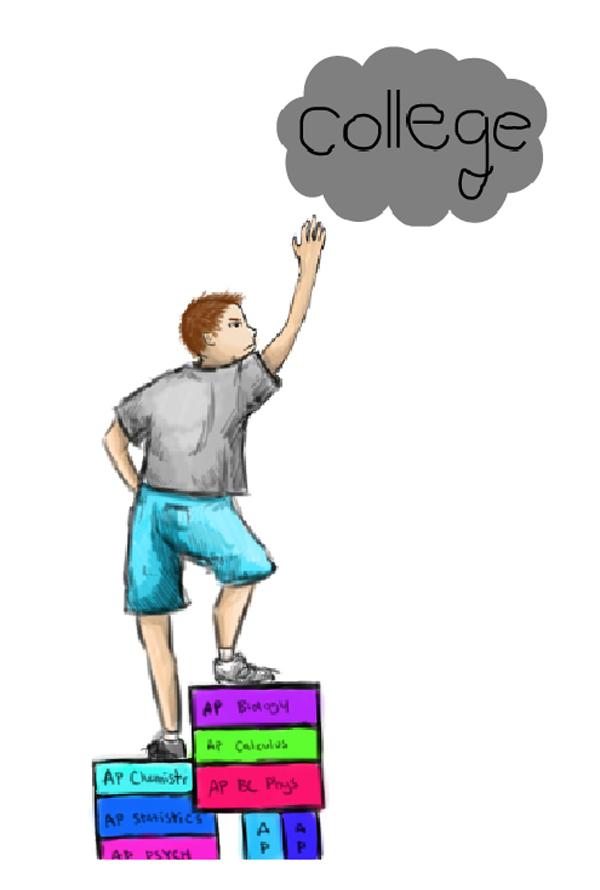
1st Period: AP Underwater Basket-weaving. 2nd period: AP Candy Cane making. 3rd period: AP Twerking. 4th Period: AP Meditating. 5th Period: AP Beard Growing. 6th Period: AP Instagram Composition. 7th Period: AP How to Cook Meat for Vegetarians.
Sound like a pointless schedule? Well, for many students loading up their schedules with AP’s, the subject matter of the course holds little significance because the students are only looking for the label the AP course provides, and that’s a problem.
It is common for students, especially those here at Paly, to take challenging courses. Over the past six years, the amount of students taking AP courses has risen by 25%, according to Diana Wilmot, director of data assessment at the Palo Alto Unified School District.
The rise in popularity of AP courses is due to many factors, but the most common reasons by far are, at root, college-based. AP classes boost students academic transcripts, and also provide benefits later on during college. Many people believe that the more AP’s, the higher one’s chances of getting into a competitive college. This belief is facilitated by the extra weight placed on AP courses by admissions officers at colleges who continue to value AP classes for the extra challenge that they provide to students and give college credit for those who pass AP courses.
If a student scores high enough on the AP exam, he or she may be permitted to place out of a required course at college. This thought process leads to many stress-increasing trends that should be cause for concern. Students are taking an increasing amount of AP courses, often more than three to four, which is the average amount of courses that college students are expected to take.
If high school AP courses truly are college level in their instruction and outside requirements, then students who take three or more AP courses a year in addition to their other courses and extracurricular activities are under a crazy burden far harsher than students taking the three to four college-level classes AP’s are based off of.
Furthermore, colleges are increasingly upping their standards for placing out, now sometimes requiring fives on the AP test (a three is regarded as a passing grade by the College Board) for students to receive college credit, or not giving the credit at all.
These ever-present college concerns have only served to tarnish the goal of the AP courses. AP classes are, according to College Board, supposed to provide “college-level course work and expectations,” which indicates that only those students who are truly ready for college in both maturity and skill level should be able to succeed in these classes.
However, two thirds of Paly’s Class of 2013 have taken (and passed) at least one AP exam, according to Wilmot, . The majority of these students are taking these courses to strengthen their transcript or gain college credit, not for the value of the course.
This practice of using the AP classes for material gain and not for the unique learning opportunity that they provide takes away from the experience of students who are truly interested in the subject. Instead of providing passionate students with a chance to explore the subjects they find interesting, AP’s are filled with students motivated by other objectives other than learning.
The standardized curriculum of AP courses further stamps out creative opportunities that a college- level course would otherwise provide. With so much material to cover, and consequences for the student, teacher and school district for low scores, no time is left for teachers to explore areas of interest and branch off from the standardized curriculum.
As John Tierney writes in the Atlantic, “The AP classroom is where intellectual curiosity goes to die.”
Although AP courses do an excellent job of teaching the material itself, and critical writing skills as well (for most subjects aside from the science and math) AP classes fail to teach students the broader skills that will help them in college and beyond.
AP courses inhibit students’ natural curiosity and do not sufficiently teach creative problem solving skills.
To solve these problems, AP courses should have a looser curriculum allowing for more intellectual exploration and a revitalized course structure in which class time is spent more on creative problem-solving and analysis instead of repetition of the facts and theories that currently dominate AP courses. Administering these changes will help our education system create a population prepared to confront the world’s problems with meaningful, creative solutions.


